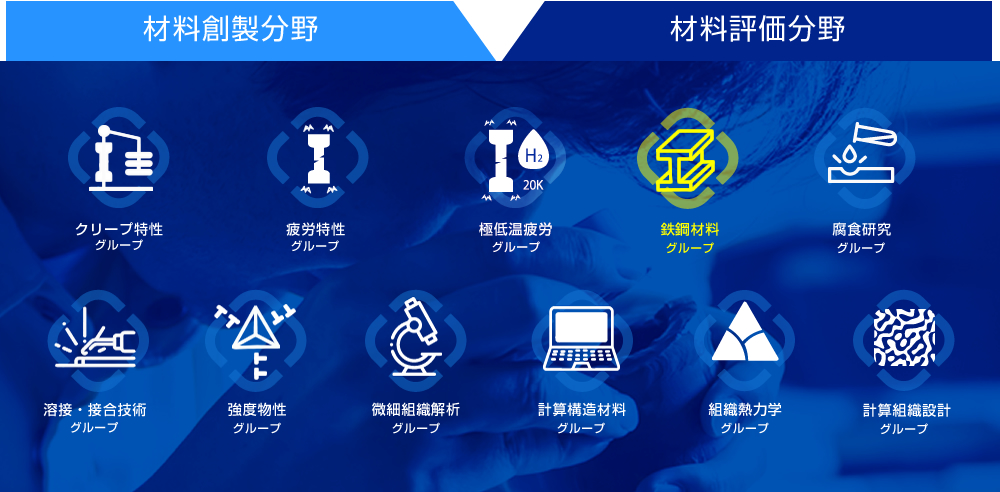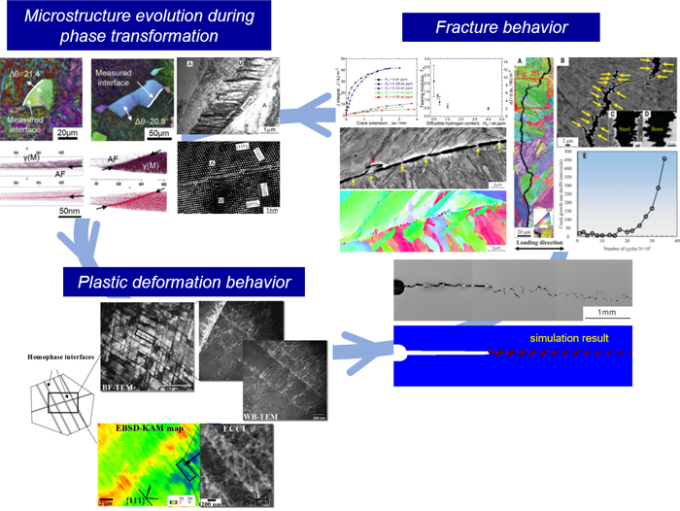 ↑他グループへはアイコンをクリック
↑他グループへはアイコンをクリック
鉄鋼材料グループ
Steel Research Group
研究概要
鋼材料は構造用材料として最も重要な材料です。鉄鋼材料研究の歴史は古いですが、鉄鋼材料科学の発展は安心・安全で持続可能な社会基盤の構築に不可欠です。鉄鋼材料の重要性は今も全く変わっておらず、むしろ増加していると言っても過言ではありません。近年、二酸化炭素排出量削減などの観点から、燃費向上を目的とした輸送機器の車体重量軽量化が急務な状況となっており、鉄鋼材料の高強度化に対するニーズが高まっています。また、資源枯渇化問題も鉄鋼材料の重要課題であり、レアメタルのうち、クロム、モリブデン、ニオブ、バナジウムなどは国内総消費量の大半が鉄鋼産業において消費されています。そのため、合金元素添加に頼らず、ミクロ組織制御によって鉄鋼材料の高強度化や耐脆性破壊特性の向上を実現していくことが非常に重要です。本グループでは、鉄鋼材料を主な研究対象とし、最先端ミクロ組織観察技術を用いた組織学的・結晶学的キャラクタリゼーションなどによって、高強度・高延性・高破壊特性を実現した鉄鋼材料を開発するための合金設計指針・ミクロ組織設計指針を理論的な背景から提案することを目指しています。
メンバー
柴田 曉伸 SHIBATA Akinobu
構造材料研究センター 材料評価分野
鉄鋼材料グループ 上席グループリーダー![]()
グティエレス ウルティア イヴァン
GUTIERREZ URRUTIA Ivan
構造材料研究センター 材料評価分野
鉄鋼材料グループ 主幹研究員
SEM, ECCI, t-EBSD, t-FSEI, in-situ SEM, 3D-Materials Sience, 3D-EBSD, 3D-labDCT, plasticity, crystal defects, mechanical behavior, high-strength steels, low-density steels
小川 祐平 OGAWA Yuhei
構造材料研究センター 材料評価分野
鉄鋼材料グループ 研究員
鉄鋼材料,オーステナイト,水素脆化,強度・延性バランス,元素戦略
岡田 和歩 OKADA Kazuho
構造材料研究センター 材料評価分野
鉄鋼材料グループ 主任研究員
専門分野・研究対象
相変態によるミクロ組織形成
鉄鋼材料は種々の相変態が生じ、それぞれの変態生成物の力学特性が異なるため、幅広い強度レベルをカバーすることができます。しかし、相変態メカニズムの理解は必ずしも十分であるとは言えません。相変態によるミクロ組織形成を正確に把握することができれば、鉄鋼材料の力学特性をさらに向上させることが可能となります。本グループでは、高強度の源であるマルテンサイト変態や新しいメタラジーの一つとして注目されている動的フェライト変態などを研究対象とし、電子顕微鏡や3次元アトムプローブによるミクロ組織・ナノスケール元素分配の解析に加えて、SPring-8やJ-PARCなどの大型研究施設を利用した格子欠陥構造解析によって、相変態によるミクロ組織形成メカニズムの解明を目指しています。
変形・破壊挙動
一般的に強度と延性はトレードオフの関係にあり、材料の強度が高くなるほど延性が低下してしまいます。強度と延性を兼ね備えた新規鉄鋼材料を設計していくためには、塑性変形挙動の詳細を明らかにしていく必要があります。本グループでは電子顕微鏡解析 / 画像相関解析 / 放射光・中性子線解析などを用いたマルチスケール解析によって、塑性変形挙動とマクロ力学特性の定量相関を解明していくための基礎研究を行っています。
また、高強度鉄鋼材料を実用化していく上で大きな問題となるのが低温脆性や水素脆性などの脆性破壊です。脆性破壊現象は、材料の強度が上昇するにつれてその発生頻度が高くなることが知られており、かつ重大事故に繋がる危険性を含んでいるため、その発生を抑制するためのミクロ組織設計・合金設計が不可欠であると言えます。本グループでは脆性破壊におけるクラック発生・伝播過程とミクロ組織の相関を電子顕微鏡や有限要素シミュレーションなどを用いて解析し、脆性破壊メカニズムの解明や、脆性破壊を抑制するための新たなミクロ組織設計・合金設計概念の確立を目指して研究を行っています。




